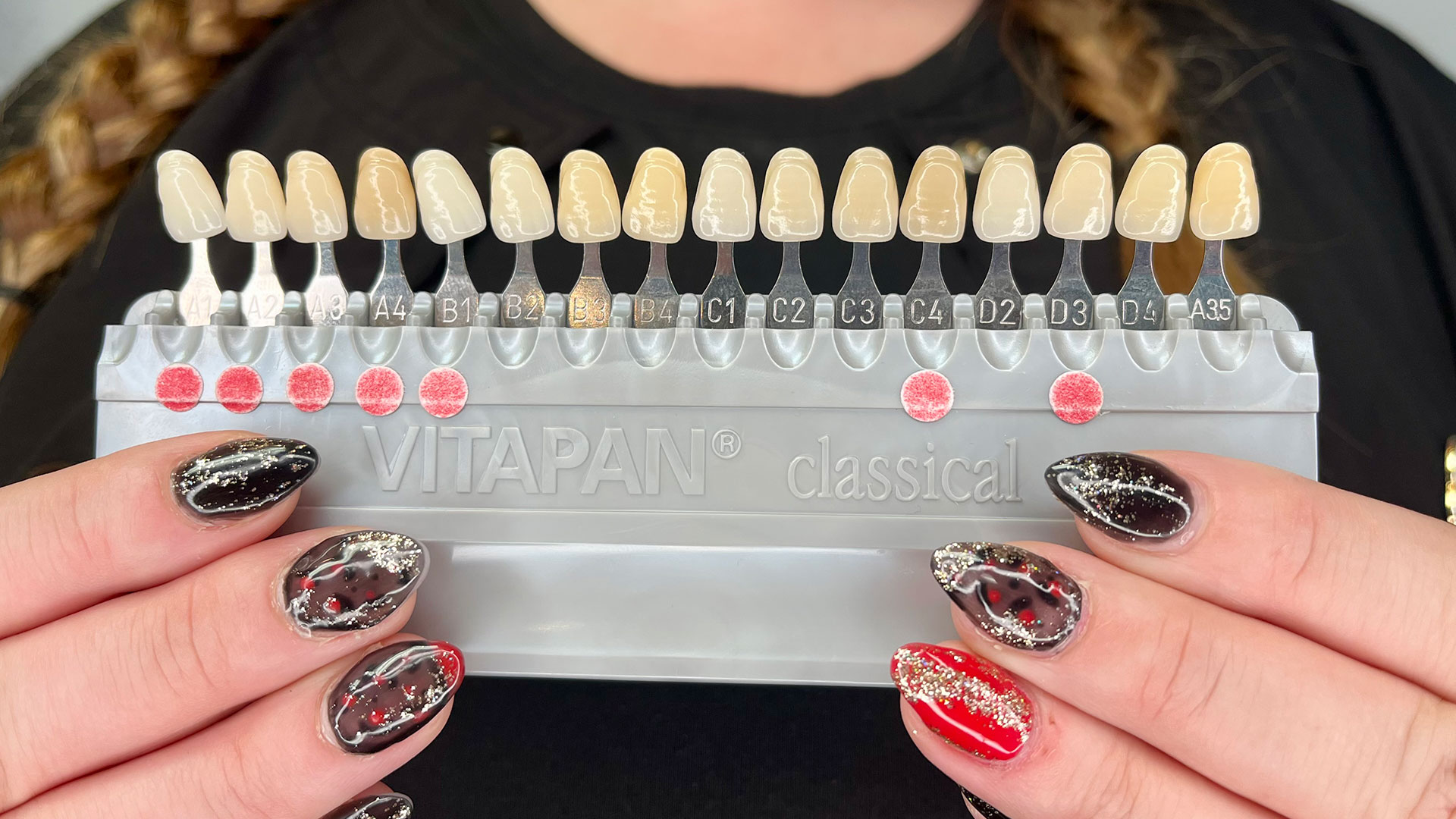Teeth whitening services have been the number one requested service in dental offices across the country with over $1.4 billion spent on over-the-counter teeth-whitening products last year alone. In-office bleaching sessions provide nearly instant results, improving tooth shades up to eight levels in just 2 hours, so it comes as no surprise that patients are eager to get this aesthetic treatment for important business or life events like conferences, vacations, or weddings. But how exactly does this treatment option work, and what makes it different from over-the-counter products like store-bought whitening gels and strips? Let’s dive deeper into the science of professional whitening services.
Basic Tooth Anatomy
To understand the teeth whitening process, we’ll first need to establish some basic tooth anatomy to understand how these areas become stained. Your teeth are made up of three main components. The white, outermost protective layer of the teeth consisting of the body’s hardest substance is called enamel. This is the part of the tooth that you see when brushing and flossing. Below the enamel layer lies dentin, the softer more porous, and yellowish layer. The innermost layer consisting of nerve endings and blood vessels, which supply the tooth with essential nutrients, is called the dental pulp. All of these layers work together to protect and nourish your teeth and are essential in maintaining good oral health. The human body is born with a fixed amount of enamel that cannot be replaced once worn down, which is why dental professionals are keen on promoting healthy habits that protect this vital substance!
Natural Tooth Shades
A lesser-known component of the teeth whitening process is understanding your body’s natural tooth shade, which is determined by genetics. There are actually 4 different basic color tones that give teeth their underlying color, including (A) reddish brown, (B) reddish yellow, (C) gray, and (D) reddish gray. Each color tone then has a range of pigmentation from low-pigmented tones to highly-pigmented tones. Whitening results, then, depend largely on what color your teeth are naturally, and typically improve up to 8 shades in a professional whitening session.
Factors that Contribute to Teeth Staining
There are many factors that contribute to teeth losing their bright, white sparkling appearance. Primarily, tooth stains are categorized as either extrinsic or intrinsic.
Extrinsic stains, also called “surface-level stains,” affect the enamel layer and are caused by factors like smoking or chewing tobacco and consuming highly-pigmented foods and beverages like tea, coffee, or pop.
Intrinsic stains are those affecting the dentin of the tooth and are caused by aging, genetics, certain developmental disorders prior to tooth eruption, gastrointestinal disorders, taking certain antibiotics, and excessive fluoride use. Additionally, decades of wear and tear and consuming a diet consisting of acidic items can thin out the enamel of the tooth, revealing more of the yellowish dentin that lies below and giving the tooth a less-than-ideal color.
What is a Stain and How Does Teeth Whitening Work?
We’ve already established that certain substances are really good at staining your teeth, but how does this work on a biological level? All stains are derived from bacteria in your mouth and consist of colorless compounds called chromogens. These chromogens have the biological potential to become pigmented when left untreated with regular brushing and flossing. The more chromogens that accumulate, the more color is produced, resulting in unwanted staining of the teeth.
Over-the-Counter Teeth Whitening Products
Nowadays there are a variety of over-the-counter whitening solutions available at drugstores, including whitening toothpastes and single-use products like Crest Whitening Strips. These products contain low concentrations of hydrogen peroxide, typically found at 3.5% concentration, and generally do a decent job of superficially improving the color of teeth. Other products like some whitening toothpastes contain abrasive materials that work to buff out stains like sandpaper, which can damage the protective enamel and inner dentin layer. Relative dentin abrasivity (RDA) is the metric that dental professionals use to determine how abrasive a toothpaste is. Research shows that toothpaste containing a value of 200 or greater is harmful to your teeth and is not advised for extended use. Here is a quick chart showing the different RDA levels:
- 0-70 (Low abrasion)
- 70-100 (Medium abrasion)
- 100-150 (High abrasion)
- 150-250 (Harmful to tooth enamel and dentin)
When using a toothpaste marketed for its whitening effects, be sure to check its RDA value to ensure you aren’t potentially damaging your tooth enamel with extended use.
Professional Teeth Whitening Services
Professional teeth whitening services use a different approach than whitening toothpastes and over-the-counter products. Instead of the 3.5% found in store-bought solutions, professional whitening systems use a 40% concentration of hydrogen peroxide applied to the teeth over a two-hour appointment. The higher concentration of hydrogen peroxide breaks apart the clusters of pigmented chromogens inside the tooth structure, creating a whiter, brighter appearance.
Here at Daia Orthodontics & TMJ Orthopedics, we use the Zoom Teeth Whitening Kit, and our patients have seen phenomenal results using this product. At your appointment, Dr. Daia will grade your existing tooth color on a scale, creating a baseline from which we can measure improvements once the procedure is complete. A lip retractor is used to keep the mouth open and the cheeks away from the whitening solution while still allowing you to comfortably bite down. Gauze is used to keep the teeth dry, and a dental dam is painted over the gumline to protect the gums from the hydrogen peroxide solution and feigns off sensitivity down the road. The whitening solution is applied to the teeth and activated by either a blue light or a laser. This light energy causes the oxygen in the gel to penetrate the teeth, helping to create the chemical reaction that breaks apart those pesky, colorful chromogens.
Typically, these sessions are scheduled for two hours, including the prepping of the mouth, as well as the active bleaching session under light therapy. Once complete, we use the same graded scale to assess your new tooth shade and measure the improvement. After confirming you are satisfied with your results, the whitening gel, dental dam, and cheek retractor are removed, and you are on your way with a new, beautiful, bright white smile.

Maintaining Your Results
As with most cosmetic procedures, you’ll want to create some helpful habits to prolong your results. Avoiding pigmented foods that stain your teeth cannot always be helped, but proper brushing after eating these items can keep your teeth whiter for a longer period. At Daia Orthodontics & TMJ Orthopedics, we provide our whitening patients with custom whitening trays and two syringes of bleaching gel to be used weekly as an at-home treatment. This allows our patients to hold on to those results and keep smiling confidently!
If you’re interested in what our Zoom Whitening Treatment can do for your smile, or if you have any questions regarding cost, procedure, and best practice, contact our office today and we will be happy to help! Make an appointment today!




